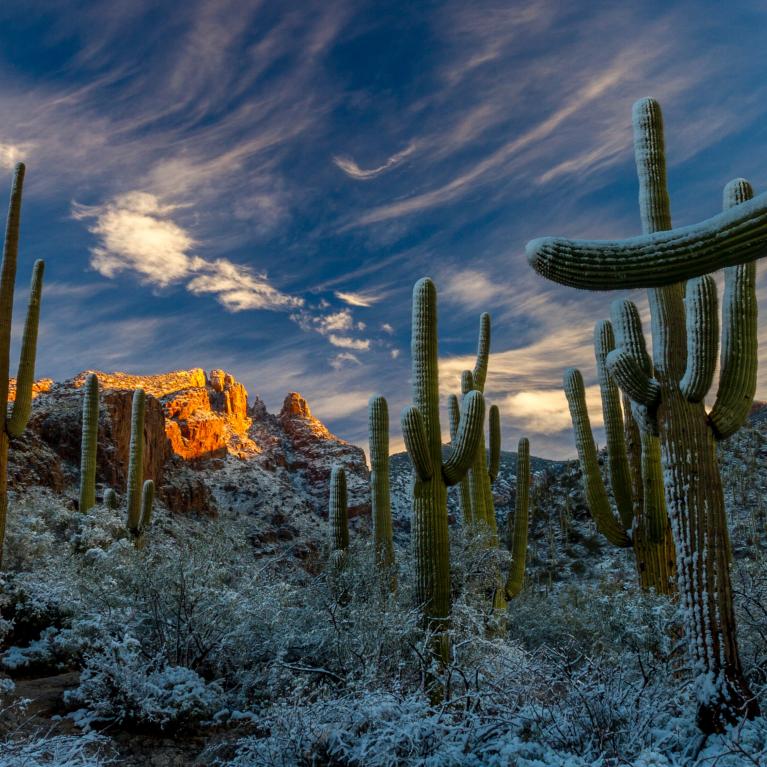Earth Science & Remote Sensing
Arizona Environment provides unparalleled expertise in the study of Earth and planetary sciences including development and application of remote sensing techniques, spatial data analysis and modeling. As a major sponsor of U.S. spacecraft missions and spatial observing systems, UArizona is renowned for Earth, Planetary, and Optical Sciences, Astronomy, and the Earth Dynamics Observatory.
Our faculty and researchers integrate across Earth and planetary sciences, combining geophysics, geochemistry, engineering, geology, and astronomy to study Earth and other planetary systems within and beyond our solar system. We work at the forefront of scientific discovery to understand the nature, genesis, and history of Earth and the solar system, and how the environment and biota at the Earth’s surface evolves and responds to a changing climate and growing population. UArizona promotes both basic and applied research, incorporating geospatial technologies and observations, field and remote sensing data and analysis, modeling of coupled human and natural systems, and decision support.
Research Spotlights in Earth Science & Remote Sensing
Willem van Leeuwen
School of Geography and Development
van Leeuwen is developing new drought and ecosystem monitoring products based on the integration of climate data and remotely sensed land surface temperature and biophysical data.
Learn moreJack Holt
Lunar and Planetary Laboratory and Geosciences
Holt is quantifying the links between regional climate, precipitation, tectonics, and the mass balance of ice sheets and glaciers.
Learn moreAli Behrangi
Hydrology and Atmospheric Sciences
Behrangi’s research interests include multi-sensor multi-spectral remote sensing of precipitation and using advanced satellite and in-situ data to improve quantification of hydrologic variables.
Learn moreKamel Didan
Agricultural Biosystems Engineering
Didan’s research explores the use of drones as a fast and cost-effective platform for land surface characterization, precision mapping, precision agriculture, and for the low-cost validation of global remote sensing data.
Learn moreArmin Sorooshian
Chemical and Environmental Engineering
Sorooshian researches the effect of aerosol particles on the environment, clouds and rainfall, climate, and public health, using a suite of synergistic methods, including ground and airborne field measurements, modeling, and remote sensing.
Learn morePaul Brierly
Yuma Center of Excellence for Desert Agriculture
Brierly uses a drone/LiDAR system to examine plant canopy geometry for crops, to assess growth and water needs, and improve agronomic planning and yield prediction in arid growing regions.
Learn more
The NSF-UA Accelerator Mass Spectrometry facility is dedicated to the study of cosmogenic isotopes, with special emphasis on radiocarbon, 14C. The laboratory acts both as an analytical resource to the general community and as a research and training center.
Read more
ART is an approved service center at The University of Arizona providing GIS related services. Specifically, they provide assistance in GIS project development, data acquisition, and spatial analysis.
Read more
ASRC works on wide range of international, national, regional, and local projects in which advanced airborne and satellite remote sensing data and other geospatial information technologies are utilized to help address both fundamental and applied issues in natural resource management.
Read more
The UA-led Santa Catalina Mountains and Jemez River Basin Critical Zone Observatory aims to improve understanding of the function, structure, and co-evolution of biota, soils, and landforms that comprise the critical zone by examining and measuring geomorphic, hydrologic, and biogeochemical interactions within it.
Read more
The Climate Dynamics and Hydrometeorology Center coordinates interdisciplinary research on hydrometeorology and climate among eleven academic units on campus and assists the transfer of hydrometeorology and climate knowledge to the local community, Arizona, the nation, and the world.
Read more
EDO supports the UA space sciences platform with a downward-looking view to Earth, specializing in satellite remote sensing to monitor and predict changes to the Earth system and inform hazards mitigation and national security in the face of natural disasters, a changing climate, and other environmental stresses.
Read more
The Tree-Ring Lab is recognized worldwide as a preeminent center for the advancement of tree-ring techniques and the broad application of dendrochronology in the social and environmental sciences.
Read more
Walnut Gulch Experimental Watershed was established in the 1950s in southeastern Arizona to study floods and the impact of soil and water conservation projects on runoff.
Read more

